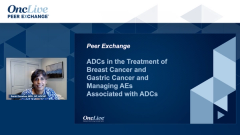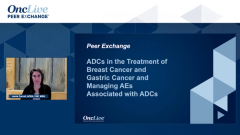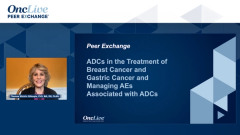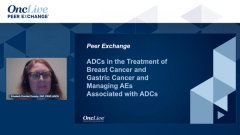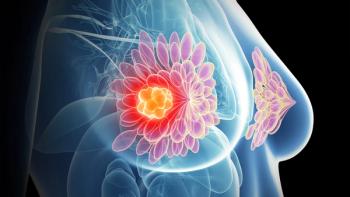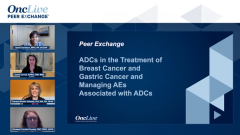
Managing AEs With Trastuzumab Emtansine in Breast and Gastric Cancers
Expert perspectives on how to best manage adverse events associated with trastuzumab emtansine while treating patients with breast or gastric cancers.
Episodes in this series

Transcript:
Sarah Donahue, MPH, NP, AOCNP: Jamie, how common is neuropathy in patients receiving T-DM1 [trastuzumab emtansine]? I think you may have reviewed this, but could you review it now?
Jamie Carroll, APRN, CNP, MSN: In these studies, it’s a pretty common thing for patients to develop peripheral neuropathy. On KATHERINE, the adjuvant study, patients had development of all grades of peripheral neuropathy, up to 32%, so it’s super common. I think it’s important to assess your patients every time you see them. Once they’re metastatic on T-DM1, we don’t tend to see them every 3 weeks. I’ll see my patients at cycle 1, cycle 2, and then usually cycle 4, cycle 6, and then start spacing out from there. I like to correlate visits with their echocardiograms, but I don’t tend to see them every 3 weeks.
I utilize other members of the care team, including the chemotherapy nurses, to ask questions and let me know if patients are having a development of any toxicity from T-DM1. Then obviously at the forefront of the health care team is the patient. It’s important that they let us know if symptoms present, and it’s important that we educate the patient to make sure that they’re aware that they need to tell us if symptoms present.
Sarah Donahue, MPH, NP, AOCNP: I can imagine patients maybe have peripheral neuropathy from their prior line of therapy, so they may be at more risk and potentially somebody you keep a closer eye on.
Theresa Wicklin Gillespie, PhD, MA, RN, FAAN: I was curious, Jamie, about your patient in the case study. I think you said she was working full-time, and I don’t know what the extent of her peripheral neuropathy was at that time, but I was wondering what kind of work she did because it’s not uncommon that the neuropathy can really interfere depending upon the kind of work people are doing.
Jamie Carroll, APRN, CNP, MSN: The patient does not have a job where she’s on her feet all the time. She does have a desk job. Then with COVID-19, she now teleworks. She works from home, so it’s I think easier for her, but her peripheral neuropathy is not too bad. I don’t have peripheral neuropathy, but she states that it’s more of a grade 1, where it’s not affecting her activities of daily living. She’s able to type, she’s able to hold a pencil, and she’s able to put in earrings, zippers, necklaces, which are all questions I ask my patients to determine how bad their neuropathy is.
Sarah Donahue, MPH, NP, AOCNP: What are the other common adverse events observed with T-DM1 in patients with metastatic breast cancer, and how is that managed? I’m seeing patients with, other than neuropathy, having low platelets and elevated liver enzymes as well, so changing the dose if we have to based on that. We do allow with thrombocytopenia for patients to get treatment if their platelets are at 75,000 or above, so we change our cutoff a little to allow them more flexibility. I think that’s normal across the board to have that as the cutoff. I’m not seeing so much neutropenia or anemia, but I do have patients with a bit of fatigue. Like I said earlier, they are really, tolerating this therapy quite well. Maybe some fatigue and a bit of nausea, but you can give them ondansetron or something like that at home and it manages it well, and it usually doesn’t last very long at all. Just a few adverse events, but nothing major that I can recall with my patients.
Jamie Carroll, APRN, CNP, MSN: Not a high percentage is reported in the studies, but one thing I’m seeing with my patients is dry mouth and dry eye. Now, I don’t know if that’s completely related to T-DM1 or related to the fact that we live in Minnesota and it’s a negative 80 degree wind chill and it’s blowing in the winter. I’m not sure if it’s completely related to the drug, but I have noticed dry eye and dry mouth. Those can be pretty significant for patients. You can’t just say drink some more water because that works for the second they’re drinking water, and then after that their dry mouth comes back, so much so that sometimes people have difficulty forming words because they just don’t have saliva in their mouth. I’m curious if you guys have noticed the dry eye and dry mouth as well.
Sarah Donahue, MPH, NP, AOCNP: I’ve certainly had patients with that, but I feel like it’s on every therapy, unfortunately. Let’s hear from you, Liz, do you have patients with that?
Elizabeth Prechtel Dunphy, DNP, CRNP, AOCN: I’ve seen more of the dry mouth than anything, but I guess with the dry eye, they go from sometimes 5-FU [fluorouracil chemotherapy], having a lot of eye tearing, to this. Maybe it’s an equal thing and that’s why they don’t complain about it, but more dry mouth is what I’ve heard, or patients have complained about.
Sarah Donahue, MPH, NP, AOCNP: Theresa, are you having that as well?
Theresa Wicklin Gillespie, PhD, MA, RN, FAAN: I would not put that on the top list of problems.
Sarah Donahue, MPH, NP, AOCNP: What monitoring parameters are considered with patients with metastatic breast cancer and starting T-DM1 to mitigate the risk of neuropathy or other adverse events? What are you checking for when they come in? I think you mentioned that a little already Jamie, but could you?
Jamie Carroll, APRN, CNP, MSN: In my case study, I talked about it a little with the prevention of peripheral neuropathy. Certainly, you want to know their baseline. Do they have other contributing comorbidities, such as diabetes, where they have preexisting peripheral neuropathy? That doesn’t mean you can’t use these drugs, but it’s important you understand their baseline so you know if they have progression. We do use cryotherapy here. I feel like patients with breast cancer are very motivated to not have adverse effects from their treatment, certainly in the neoadjuvant/adjuvant setting, but also in the metastatic setting. We often recommend cryotherapy for those patients. Before COVID-19, we had gel mittens and booties we would loan patients for the day. That went away, so now either they use ice, or we recommend Elasto-Gel mittens and booties. You can order these from Amazon for $100.
Sarah Donahue, MPH, NP, AOCNP: They bring those on ice?
Jamie Carroll, APRN, CNP, MSN: They’re like a gel, so they bring them and stick their hands in. A lot of times, they’re so cold that after 15 minutes they need to bring their hands out, warm them up, and put them back in. But most of the time they’re motivated to not get neuropathy so they’re willing to do it.
Sarah Donahue, MPH, NP, AOCNP: We also use that where I am. That’s nice that you guys provided the gel for a while there, the gel gloves.
Transcript edited for clarity.
Newsletter
Knowledge is power. Don’t miss the most recent breakthroughs in cancer care.

